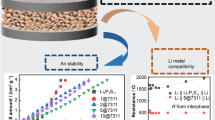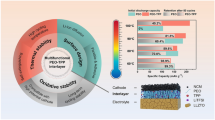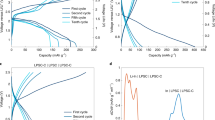Abstract
For lithium battery systems including solid-state batteries, the solid electrolytes are playing an important role in enhancing the lithium transportation through the electrode/electrolyte interface resulting in the enhanced electrochemical performance of active materials which can prevent the dendrite formation for long term cycle life. However, the formation of the solid electrolyte film on the materials' surface is carrying on via various types of methods. Especially for oxide-salt-type of solid electrolytes of Li2O–MxOy–LixXy system, these solid electrolyte is forming on the surface of materials via the melt quenching technique at above 500 °C that can lead to the unstable and degradation the structure of the active materials resulting in the lower performance compared to the traditional (wet-chemistry or solid stare reaction) formation of solid electrolyte film. In this work, the thermochemical stability of the active material in contact with the solid electrolyte after formation via a high-temperature method is investigated by the thermogravimetric and X-ray diffraction analysis, and galvanostatic charge–discharge and cyclic voltammetry measurements confirm that the electrochemical degradation can be attributed mainly to the partial destruction of cathode structure and surface oxidation of current collector leading to the lower electrochemical performance. The results suggest that the process formation of solid electrolyte film of the oxide-salt system should not exceed 250–300 °C and is highly relevant to a critical area for the active electrode materials without the degradation of the material structure and decreasing electrochemical performance.
Graphic abstract








Similar content being viewed by others
References
M.R. Palacin, Recent advances in rechargeable battery materials: a chemist’s perspective. Chem. Soc. Rev. 38, 2565–2575 (2009)
Q. Li, J. Chen, L. Fan, X. Kong, Y. Lu, Progress in electrolytes for rechargeable Li-based batteries and beyond. Green Energy & Environ. 1, 18–42 (2016)
M.S. Whittingham, Lithium batteries and cathode materials. Chem. Rev. 104, 4271–4301 (2004)
L. Suo, F. Han, X. Fan, H. Liu, K. Xu, C. Wang, "Water-in-salt” electrolytes enable green and safe Li-ion batteries for large scale electric energy storage applications. J. Mater. Chem. A 4, 6639–6644 (2016)
A. Tron, Y.N. Jo, S.H. Oh, Y.D. Park, J. Mun, Surface modification of the LiFePO4 cathode for the aqueous rechargeable lithium ion battery. ACS Appl. Mater. Interfaces 9, 12391–12399 (2017)
Y. Wang, W.D. Richards, S.P. Ong, L.J. Miara, J.C. Kim, Y. Mo, G. Ceder, Design principles for solid-state lithium superionic conductors. Nature Mater. 14, 1026–1031 (2015)
A. Tron, A. Nosenko, Y.D. Park, J. Mun, Synthesis of the solid electrolyte Li2O−LiF−P2O5 and its application for lithium-ion batteries. Solid State Ionics 308, 40–45 (2017)
W. Zhou, Y. Li, S. Xin, J.B. Goodenough, Rechargeable sodium all-solid-state battery. ACS Cent. Sci. 3, 52–57 (2017)
K. Takada, Progress and prospective of solid-state lithium batteries. Acta Mater. 61, 759–770 (2013)
J.W. Fergus, Ceramic and polymeric solid electrolytes for lithium-ion batteries. J. Power Sources 195, 4554–4569 (2010)
R.C. Agrawal, R.K. Gupta, Superionic solids: composite electrolyte phase — an overview. J. Mater. Sci. 34, 1131–1162 (1999)
V.K. Deshpande, S.G. Charalwar, K. Singh, Electrical conductivity of Li2O-B2O3-P2O5-Li2SO4 glass system. Solid State lonics 40(41), 689–692 (1990)
I.Y. Kim, S.H. Jee, Y.S. Yoon, High-speed deposited amorphous Li–B–W–O thin film electrolytes for all-solid-state batteries. Sci. Adv. Mater. 8, 96–102 (2016)
A. Tron, A. Nosenko, Y.D. Park, J. Mun, Enhanced ionic conductivity of the solid electrolyte for lithium-ion batteries. J. Solid State Chemistry 258, 467–470 (2018)
E.M. Shembel, A.V. Nosenko, A.M. Kvasha, Solid vitreous electrolytes based on the system Li2O-Li2SO4-B2O3-MoO3 for rechargeable lithium power sources. Ionics 11, 132–139 (2005)
A. Hayashi, M. Tatsumisago, T. Minami, Electrochemical properties for lithium ion conductive (100-x) (0.6Li2S-0.4SiS2)xLi4SiO4 oxysulfide glasses. J. Electrochem. Soc. 146, 3472–3475 (1999)
S. Ujiie, A. Hayashi, M. Tatsumisago, Structure, ionic conductivity and electrochemical stability of Li2S–P2S5–LiI glass and glass–ceramic electrolytes. Solid State Ionics 211, 42–45 (2012)
T. Ohtomo, A. Hayashi, M. Tatsumisago, Y. Tsuchida, S. Hama, K. Kawamoto, All-solid-state lithium secondary batteries using the 75Li2S⋅25P2S5 glass and the 70Li2S⋅30P2S5 glass-ceramic as solid electrolytes. J. Power Sources 233, 231–235 (2013)
K. Takada, N. Aotani, K. Iwamoto, S. Kondo, Solid state lithium battery with oxysulfide glass. Solid State Ionics 86–88, 877–882 (1996)
E. Shembel, A. Kvasha, A. Nosenko, Y. Pustovalov, P. Novak, Half-cells based on solid vitreous electrolyte and thermo expanded graphite, 6th Advanced Batteries and Accumulators – ABA-2005, Brno, Czech Republic.
A. Tron, Y.D. Park, J. Mun, AlF3-coated LiMn2O4 as cathode material for aqueous rechargeable lithium battery with improved cycling stability. J. Power Sources 325, 360–364 (2016)
J. Wang, Q. Zhang, X. Li, Z. Wang, K. Zhang, H. Guo, G. Yan, B. Huang, Z. He, A graphite functional layer covering the surface of LiMn2O4 electrode to improve its electrochemical performance. Electrochem. Commun. 36, 6–9 (2013)
J. Kim, H. Kang, N. Go, S. Jeong, T. Yim, Y.N. Jo, K.T. Lee, J. Mun, Egg-shell structured LiCoO2 by Cu2+ substitution to Li+ sites via facile stirring in an aqueous copper(ii) nitrate solution. J. Mater. Chem. A 5, 24892–24900 (2017)
M.K. Devaraju, I. Honma, Hydrothermal and solvothermal process towards development of LiMPO4 (M = Fe, Mn) nanomaterials for lithium-ion batteries. Adv. Energy Mater. 2, 284–297 (2012)
J.S. Gnanaraj, V.G. Pol, A. Gedanken, D. Aurbach, Improving the high-temperature performance of LiMn2O4 spinel electrodes by coating the active mass with MgO via a sonochemical method. Electrochem. Commun. 5, 940–945 (2003)
Y. Fang, Y. Huang, S. Zhang, W. Jia, X. Wang, Y. Guo, D. Jia, L. Wang, Synthesis of unique hierarchical mesoporous layered-cube Mn2O3 by dual-solvent for high-capacity anode material of lithium-ion batteries. Chem. Eng. J. 315, 583–590 (2017)
T. Aoshima, K. Okahara, C. Kiyohara, K. Shizuka, Mechanisms of manganese spinels dissolution and capacity fade at high temperature. J. Power Sources 377, 97–98 (2001)
X. Gao, Y. Sha, Q. Lin, R. Cai, M.O. Tade, Z. Shao, Combustion-derived nanocrystalline LiMn2O4 as a promising cathode material for lithium-ion batteries. J. Power Sources 275, 38–44 (2015)
R.A. Robie, D.R. Waldbaum, Thermodynamic Properties of Minerals and Related Substances at 298.15°K (25.0 °C) and One Atmosphere (1.013 bars) Pressure and at Higher Temperatures, Geological Survey Bulletin 1259, U.S. Government Printing Office, Washington, 1968.
C. Yang, Y. Deng, M. Gao, X. Yang, X. Qin, G. Chen, High-rate and long-life performance of a truncated spinel cathode material with off-stoichiometric composition at elevated temperature. Electrochim. Acta 225, 198–206 (2017)
A. Tron, A. Nosenko, Y.D. Park, J. Mun, The solid electrolytes Li2O-LiF-Li2WO4-B2O3 with enhanced ionic conductivity for lithium-ion battery. J. Ind. Eng. Chem. 73, 62–66 (2019)
Acknowledgements
This work was supported by the Post-Doctoral Research Program (2017–2018) in the Incheon National University (INU), Incheon, Republic of Korea.
Author information
Authors and Affiliations
Corresponding author
Additional information
Publisher's Note
Springer Nature remains neutral with regard to jurisdictional claims in published maps and institutional affiliations.
Rights and permissions
About this article
Cite this article
Tron, A., Nosenko, A. & Mun, J. Thermal stability of active electrode material in contact with solid electrolyte. J. Korean Ceram. Soc. 59, 193–201 (2022). https://doi.org/10.1007/s43207-021-00164-y
Received:
Revised:
Accepted:
Published:
Issue Date:
DOI: https://doi.org/10.1007/s43207-021-00164-y




